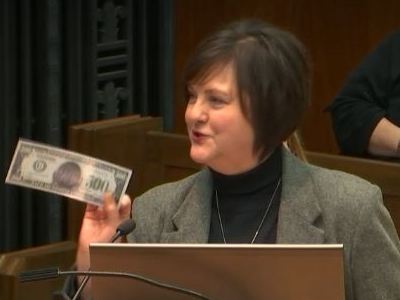I enjoyed the article "125 years of a LEGACY: Local artists, aficionados celebrate Grant Wood" by Tia Carol Jones in yesterday’s
Telegraph Herald. Here's some more info.
On February 18, 1942, a few days after Grant Wood died, the
TH described how years earlier the Carnegie-Stout Public Library Board purchased
The Appraisal for $350 and
Victorian Survival for $800.
At that time in 1934,
the article says, the library board also had the opportunity to purchase Wood's satirical painting,
Daughters of Revolution, but they decided it was too controversial, and actor Edward G. Robinson ended up buying it.
While
The Appraisal below doesn't seem controversial, the library board might not have known that the woman holding the chicken in the painting was actually a man, Cedar Rapids gallery director Ed Rowan.
The other painting,
Victorian Survival, was one of Grant Wood's favorites. He would only sell it to the library board if they agreed in advance to lend it back to him for future exhibitions. Thankfully, they agreed.
There are different theories about
Victorian Survival. The main one seems to be that the old-fashioned lady resents the new-fangled telephone. But could it be the other way around? Is she trying to hide her fondness for it?
Art professor R. Tripp Evans puts it this way in his 2010 biography of Grant Wood:
Lying in shadow behind Aunt Tillie, whose concealed right hand itself indicates a note of treachery, the telephone is more accomplice than opponent--an offstage voice, whispering something salacious (and apparently mortifying) into Aunt Tillie's overscaled ear.
I agree with Tim Olson's assessment, "
Victorian Survival is just weird." Weird and cool! And we're so lucky to have it in Dubuque!
~Mike, Adult Services
---
Note:
Grant Wood visited Dubuque several times. Here's an announcement of one visit from the
TH arts column, "'Mid Pallettes and Clefs," from March 6, 1932:
I wonder if this irregular column, which sometimes was signed by "Be-Be," might have been written by John Mulgrew, the original "Jazbo of Old Dubuque."







 Updated: January 2, 2025
Updated: January 2, 2025

















